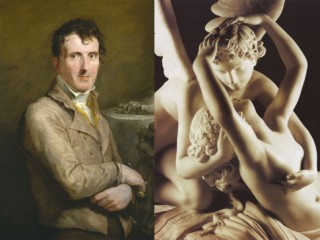
Antonio Canova biography
Date of birth : 1757-11-01
Date of death : 1822-10-13
Birthplace : Possagno, venice, Italy
Nationality : Italian
Category : Famous Figures
Last modified : 2010-12-20
Credited as : Artist sculptor, the neoclassic style,
The Italian sculptor Antonio Canova was a leading exponent of the neoclassic style, which dominated the arts in the late 18th and early 19th centuries. Internationally famous, he was regarded as the most brilliant sculptor in Europe.
Antonio Canova was born in Possagno near Venice on Nov. 1, 1757. He displayed a talent for sculpture while still very young and by 1774 had established his own studio in Venice, where he produced portrait busts and other sculptures for the Venetian nobility. In 1779 Canova left Venice to travel and to study in southern Italy; during the following 2 years he worked in Rome and visited Herculaneum and Pompeii, ancient Roman cities which had been excavated in the middle of the 18th century. By 1781, the year he took up permanent residence in Rome, Canova was thoroughly committed artistically to the neoclassic style, which was sweeping all the arts.
During the first half of the 18th century the arts had been dominated by the rococo, a light, playful, and aristocratic style. By the 1760s, however, the rococo was under attack by intellectuals and critics as being trivial and frivolous, and at the same time several important books were published concerning ancient Greek and Roman art and architecture. Fashionable and artistic taste began to shift slowly from the rococo to the art of antiquity, and when Canova reached maturity as a sculptor, neoclassicism had achieved a virtually complete triumph in painting, sculpture, architecture, and the decorative arts. Canova's passion for ancient art and his study of it, combined with his particular talents and the taste of the period, led him to the heights of success as a champion of neoclassicism in sculpture.
Between 1783 and his death nearly 40 years later, Canova received important and extensive commissions from the popes, Napoleon, the Hapsburgs, and members of the English aristocracy. He traveled widely and worked in Rome, Paris, and Vienna. His statues became so popular that he utilized many assistants and various mechanical techniques in order to meet the demands made upon him. In 1805, by which time his reputation as the most eminent sculptor in Europe was firmly established, he was appointed by Pope Pius VII as inspector general of fine arts and antiquities for the Papal States. Five years later he became director of the Academy of St. Luke in Rome, the official art academy of the Papal States.
Canova's mature style derived specifically and directly from ancient Greek and Roman sculpture, and his subject matter was most often taken from classical mythology. Perseus (1801) reflects his classical taste for idealization, expressed in carefully controlled harmonies of proportion, clear line, smooth modeling, and sleek surfaces. Two famous and typical works which he created for the Bonaparte family are the monumental marble statues of Napoleon (1802-1810) and of Napoleon's sister, Pauline Borghese (1808). In the statue of Napoleon, which is nearly 12 feet high, Canova presented the victorious Bonaparte as a nude Roman emperor, his facial features made to conform to the classical ideal. Princess Borghese, life-size and partly draped, is shown as Venus reclining on a couch. Both works are notable for dependence upon Hellenistic sources, idealized perfection of the forms, fluidity of line, graceful modeling, and exquisitely refined detail.
Canova died in Venice on Oct. 13, 1822. He created a classic ideal of human beauty which exerted a strong influence on academic sculpture during most of the 19th century. Late in the century, however, Canova's work was harshly criticized as cold, lifeless, uninspired, and a mere imitation of ancient art. This adverse critical judgment of Canova's sculpture prevailed well into the 20th century, but recent and more objective studies of the entire neoclassic movement have tended to restore to Canova's reputation some of the luster which it possessed during his lifetime.
The most important monograph on Canova is in Italian: Elena Bassi, Canova (1943). In English, an interesting and decidedly adverse evaluation of Canova's work may be found in Sir Kenneth Clark, The Nude: A Study in Ideal Form (1956). A different and more favorable view of Canova is expressed in Sir Osbert Sitwell, Winters of Content (1932). For examinations of Canova within the context of his era and for discussions of neoclassicism see Fritz Novotny, Painting and Sculpture in Europe: 1780-1880 (1960); Robert Rosenblum, Transformations in Late Eighteenth-Century Art (1967); and Hugh Honour, Neo-Classicism (1968).
















